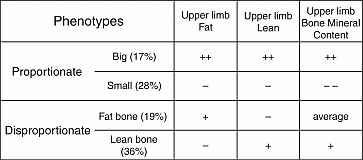ICCBH2013 Oral Communications Epidemiology (6 abstracts)
Novel musculoskeletal phenotypes during childhood for epidemiological studies
Rajbir N Batra 1,* , Nicholas C Harvey 2 , Zoë A Cole 2 , Pat Taylor 3 , Cyrus C Cooper 1, , M Kassim Javaid 1, & The Southampton Women’s Survey Study Group 2
1Oxford NIHR Musculoskeletal Biomedical Research Unit, Nuffield Department of Orthopaedics, Rheumatology and Musculoskeletal Sciences, University of Oxford, Oxford, UK; 2MRC Lifecourse Epidemiology Unit, University of Southampton, Southampton General Hospital, Southampton, UK; 3Department of Medical Physics and Bioengineering, Southampton University Hospitals, National Health Service Trust, Southampton General Hospital, Southampton, UK. *Winner of New Investigator Award
Objectives: Bone, muscle and fat share common mesenchymal origins yet current methods separately examine lean, fat and/or bone content. We hypothesized specific musculoskeletal phenotypes derived from relative contributions of each tissue.
Methods: Design: We obtained information from the 6-year follow-up of mother–offspring pairs within the Southampton Women’s Survey, a prospective population-based cohort study of 12 583 initially non-pregnant women.
Measurements: Fat, lean and bone mineral content of the offspring’s upper limbs were measured by DXA (Hologic Discovery, MA, USA). The following maternal characteristics were used: pre-pregnancy height and weight; early pregnancy triceps skinfold thickness; late pregnancy smoking status, strenuous activity and serum 25(OH)-vitamin D concentration (Diasorin, MN, USA).
Statistics: Two-stage variable clustering was used to identify statistically independent phenotypes based on arm fat, lean and bone mineral content using log-likelihood and Bayesian Information Criterion. We tested predictors of the clusters adjusting for the child’s sex and age at time of DXA scan using logistic regression.
Results: 1050 offspring (median age 6.8 years; 52% boys) had whole body DXA. Using the above methods, four independent phenotypes were identified (Fig. 1): two proportionate phenotypes – big (17%) and small (28%); and two disproportionate – fatty bone (19%) and lean bone (36%). Within proportionate offspring, big phenotype had significantly higher maternal weight (P=0.001), height (P<0.001) and smoking during pregnancy (P=0.024) compared to small. Within disproportionate offspring, increased maternal triceps skinfold (P=0.001) and lower 25(OH)-vitamin D concentrations (P=0.012) were independent determinants of fatty vs lean bone phenotypes.

Figure 1 DXA-derived fat, lean and bone mineral content composition for each of the four upper limb phenotypes. ‘+’ and ‘−’ for each of upper limb fat, lean and bone mineral content indicate comparison of each phenotype to the total sample.
Conclusion: We have identified novel composition phenotypes that have distinct early life predictors. These phenotypes may offer insights into aetiopathogenesis of growth and inform future research into the impact of early environment on clinical outcomes in later life.
 }
}



